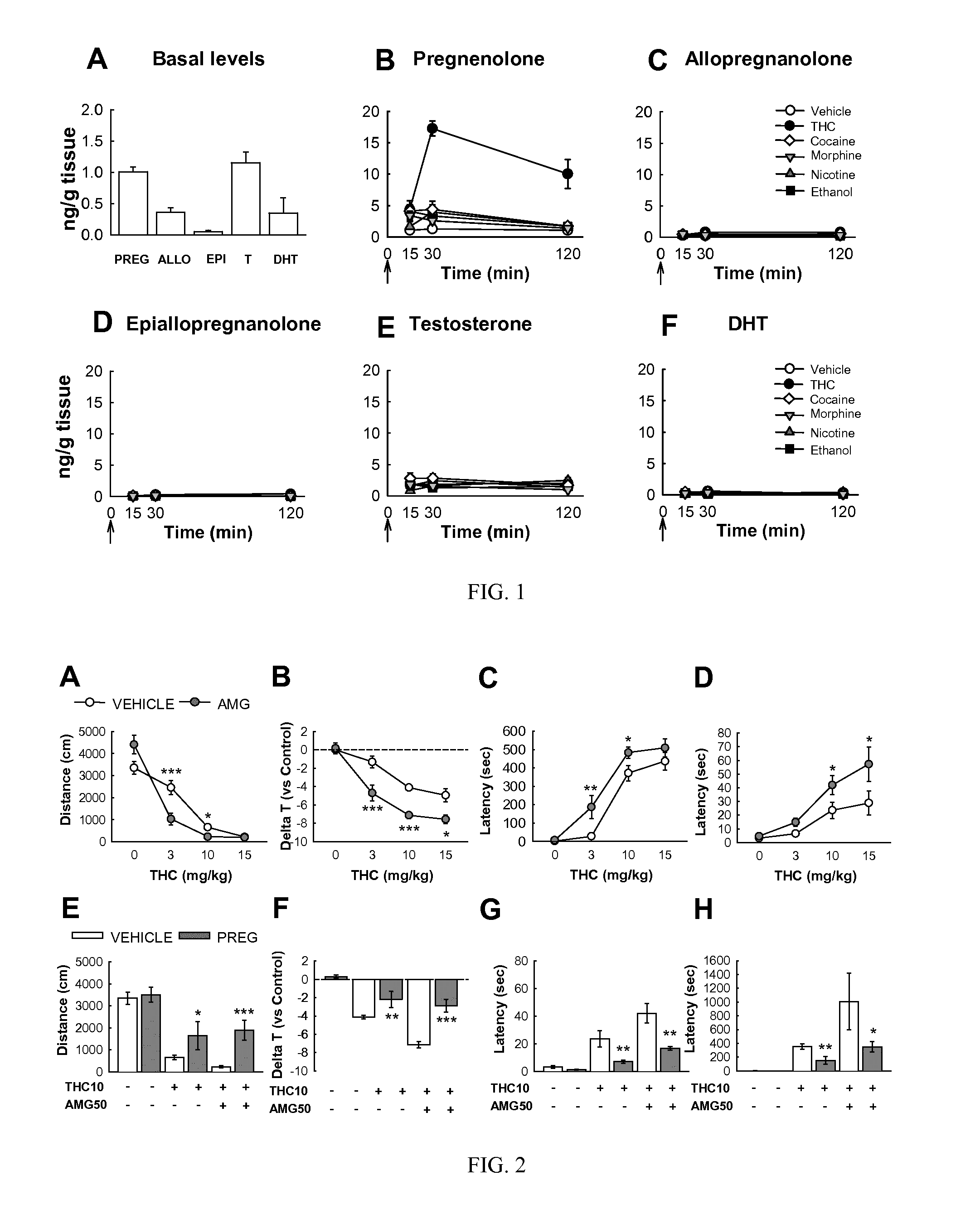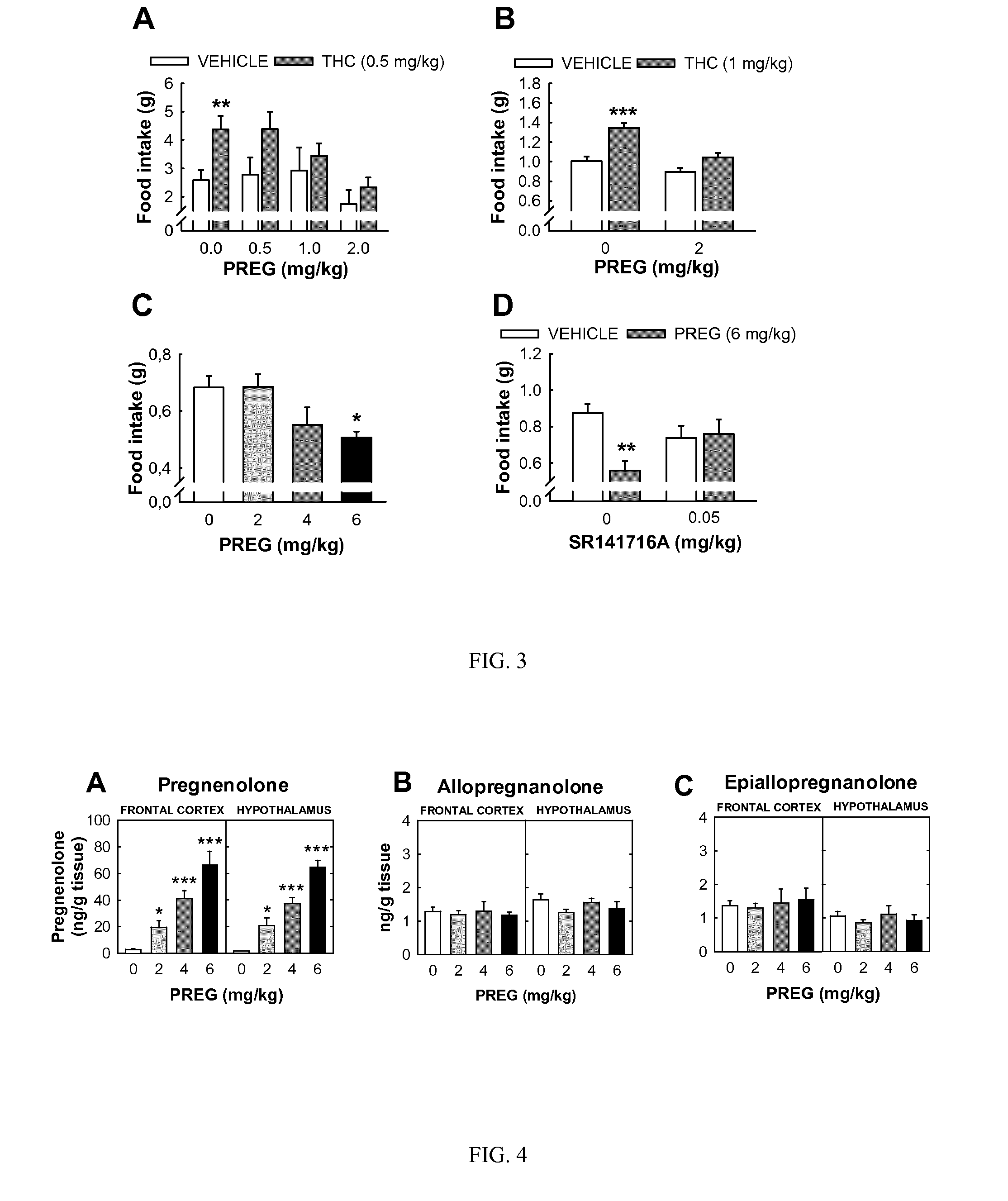Antagonists of CB1 Receptor
- Summary
- Abstract
- Description
- Claims
- Application Information
AI Technical Summary
Benefits of technology
Problems solved by technology
Method used
Image
Examples
example 1
THC Increases Pregnenolone Concentrations in the Brain More than Other Drugs of Abuse
[0548]In this example the inventors analyzed the effects of the injection of the principal drugs of abuse on the production of pregnenolone in male Wistar rats. In all tissues, the first step of steroid synthesis is the production of pregnenolone that has been largely considered as an inactive precursor of downstream active molecules. For example, in the brain, starting from pregnenolone two parallel enzymatic cascades allow producing on one hand allopregnanolone and its stereoisomer epiallopregnanolone and on the other testosterone and its metabolite DHT. These brain steroids were quantified using GC-MS, the only technique able to differentiate their subtle structural differences. The major classes of drugs of abuse were injected subcutaneously or intraperiotenally at doses corresponding to the ED50 for most of their unconditioned behavioural effects: the psychostimulant cocaine (20 mg / kg), the opi...
example 2
THC Increases Pregnenolone Concentrations in the Brain of Rats in a Dose Dependent Manner
[0550]In this example the inventors further characterized the effects of the administration of different concentrations of THC (0.3, 0.9, 1.5, 3, 6 and 9 mg / kg) or vehicle to male Wistar rats on body concentrations of pregnenolone measured at the pick of the drug effects that, as shown in the previous example, was observed 30 min after the injection. These experiments demonstrated that the increase in pregnenolone observed in the brain was dose dependent, with an ED50 of approximately 3 mg / kg. The example provides data obtained in the plasma and in several brain structures: frontal cortex (FCX); nucleus accumbens (ACC); striatum (STR); hypothalamus (HYP). After THC administration, pregnenolone increased in all the studied brain structures in a comparable manner. Pregnenolone also increased in the plasma but this increase was several times lower than the one observed in the brain.
example 3
THC Increases Pregnenolone Concentrations in the Brain of Mice in a Dose Dependent Manner
[0551]In this example the inventors further characterized the effects of the administration of THC on concentrations of pregnenolone by studying the effects of THC in the mouse. Pregnenolone was measured at the pick of the drug effects, 30 min after the injection. These experiments demonstrated that THC induced a dose-dependent increase in pregnenolone also in mice. The example provides data obtained from the several brain structures: frontal cortex (FCX); nucleus accumbens (ACC); striatum (STR). THC induced a similar increase in pregnenolone concentration in all these brain structures.
PUM
 Login to View More
Login to View More Abstract
Description
Claims
Application Information
 Login to View More
Login to View More - R&D
- Intellectual Property
- Life Sciences
- Materials
- Tech Scout
- Unparalleled Data Quality
- Higher Quality Content
- 60% Fewer Hallucinations
Browse by: Latest US Patents, China's latest patents, Technical Efficacy Thesaurus, Application Domain, Technology Topic, Popular Technical Reports.
© 2025 PatSnap. All rights reserved.Legal|Privacy policy|Modern Slavery Act Transparency Statement|Sitemap|About US| Contact US: help@patsnap.com



